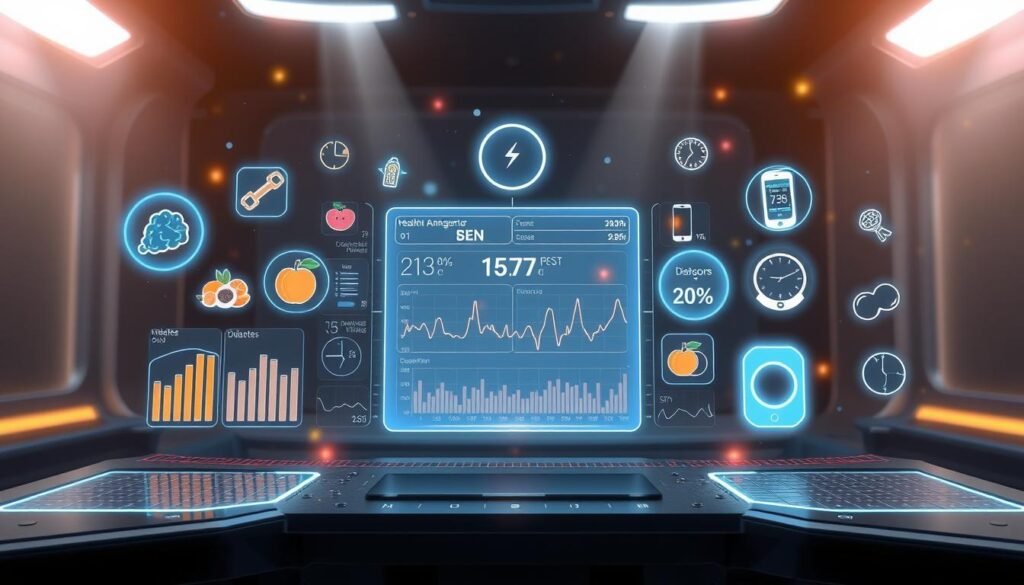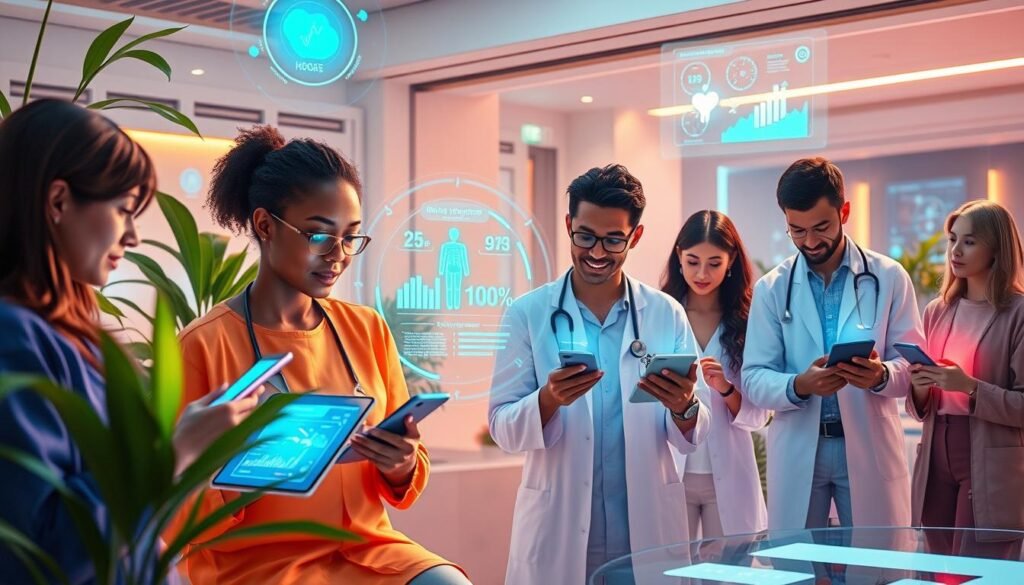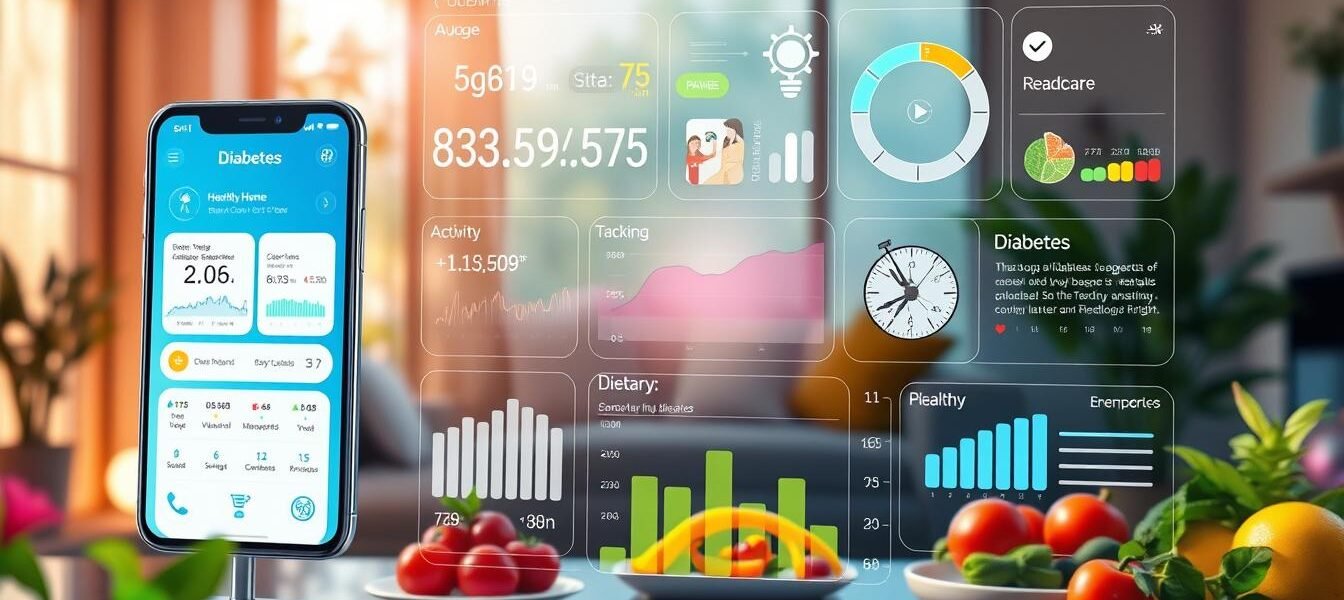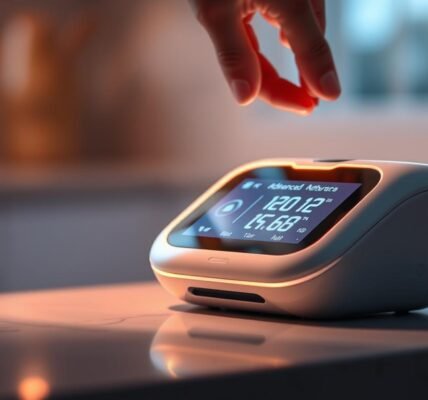Could digital therapeutics be the game-changer for reversing diabetes? They’re changing how we manage our health. Digital therapeutics for diabetes use software to create personalized plans for you. They help you reach your goal of reversing diabetes, which means keeping your HbA1c under 6.5% without meds.
Studies show these digital programs work well. For example, the Fitterfly Diabetes CGM program cut HbA1c by 1.2% in 90 days1. People also lost weight and saw better blood sugar levels1. As the digital health market grows, these tools will be key in fighting diabetes2. Let’s dive into how digital therapeutics can help you live a healthier life.
Key Takeaways
- Digital therapeutics provide personalized treatment for diabetes management.
- A significant reduction in HbA1c levels can be achieved using innovative digital solutions.
- The digital health market is rapidly expanding, offering numerous opportunities for diabetes care.
- Online platforms connect patients with healthcare providers for optimized diabetes management.
- These therapeutics are making diabetes reversal more accessible and realistic.
Understanding Diabetes Reversal
Diabetes reversal is a big change from usual diabetes care. It aims to get blood sugar back to normal without drugs. This goal is reached by controlling HbA1c levels, showing better health.
Studies show that diabetes remission is more likely in the first five years. It can last up to ten years in some cases3. Things like BMI and drug use play big roles in success. People with a BMI over 25 and those on fewer drugs have a better chance3.
New programs using digital tools are showing great results. They aim to reverse diabetes and improve health with custom plans. For example, Diabefly has seen 95% of users manage their blood sugar better3.
Using precision nutrition is also promising. A study in India used digital twins for nutrition therapy. It showed big improvements in diabetes reversal stages in an Indian study. This shows how tailored nutrition can help control HbA1c and improve diabetes health.
What Are Digital Therapeutics?
Digital therapeutics are a new way to manage health issues like diabetes. They use software to offer evidence-based therapies that meet each patient’s needs. With diabetes affecting 536.6 million people in 2021, and expected to hit 783.2 million by 2045, the need for new diabetes treatment technology is huge4.
These technologies include advanced medical software that works well with traditional care.
Digital therapeutics are very effective in getting patients to stick to their treatment plans. A study found that patients using these tools had much lower HbA1C levels than those who didn’t. This shows their power in controlling blood sugar levels4.
Also, venture capital has invested over $1.3 billion in digital therapeutics from 2011 to 2019. This highlights the sector’s potential in diabetes management4.
Almost 5,000 studies have shown how effective prescription digital therapeutics are. They help with diabetes education, self-management, and mental health. By adding FDA-approved digital therapeutics to care, doctors can improve patient health outcomes5.

Digital Therapeutics for Diabetes
Digital therapeutics have changed how we manage diabetes. They offer personalized plans tailored for each person. Using digital health platforms and smart algorithms, these tools keep a close eye on your health. This means you get updates and tips to help you manage diabetes better.
Personalized Treatment Plans
Personalized care is key in diabetes treatment today. Digital tools use data to make plans just for you. For example, they help you track your blood sugar levels easily.
They also give you diet tips that fit your life. These tools remind you to take your meds and track your progress. This leads to better health and more consistent care.
Data-Driven Insights for Better Care
Data insights make managing diabetes easier. Digital platforms with AI give you useful info. They look at your sugar levels, insulin use, and lifestyle.
These tools make tracking easier and help doctors understand you better. With apps, you get advice that’s just right for you. More people are using these tools, showing they’re the future of diabetes care67.
The Role of AI in Diabetes Management
Artificial intelligence is changing how we manage diabetes, making care more personal and effective. It uses machine learning to predict what patients need and adjust treatments. The International Diabetes Federation says 425 million people worldwide had diabetes in 2017, leading to 4 million deaths. This shows we need better ways to manage diabetes fast8.
Application of Machine Learning
Machine learning is being used more in diabetes care. It helps doctors make better choices with data. From 2010 to 2018, 1849 articles about AI in diabetes were published. This shows a lot of interest and research in this area8.
These AI systems use health data to predict problems and help with decisions. This lets doctors manage patients better ahead of time.
Predictive Analytics for Patient Outcomes
Predictive analytics in diabetes helps understand patient outcomes better. A review found that using different types of data made AI models more accurate. For example, one model predicted type 2 diabetes with an accuracy of 0.969.
Using many kinds of data and methods is key to improving AI in diabetes care.

As AI becomes more common in diabetes care, focusing on data quality is crucial. It’s important to work together to make reliable AI tools for diabetes. This includes addressing issues like data gaps and model accuracy9.
Benefits of Digital Health Solutions
Digital health solutions are changing how we care for diabetes. They make it easier to get help, especially with telehealth for diabetes. This service removes barriers based on where you live. With almost two-thirds of people worldwide having internet, you can manage your diabetes from anywhere10.
This makes it easier for patients to take charge of their health. It’s all about making care more accessible and user-friendly.
Enhanced Accessibility to Care
Telehealth for diabetes lets you talk to doctors without going to the office. It saves time and money on travel. In 2021, investors put $57.2 billion into digital health, showing they believe in it11.
Remote monitoring is key. It gives patients tools to track their health at home.
Cost-Effective Management
Digital health is also cheaper for managing diabetes. Studies show it can lower hemoglobin A1c levels by one percentage point10. This is a big deal for diabetes control.
Remote monitoring can cut hospital readmissions by 50% for heart attacks. This means lower healthcare costs11. It’s all about making care affordable and accessible for the long term.
Precision Nutrition in Diabetes Reversal
Nutrition plays a huge role in reversing diabetes. Good dietary management means using precision nutrition that fits your needs. Digital health platforms help create diet plans that meet your unique nutritional needs.
Tailored Diet Plans
Using tailored diet plans is key in managing diabetes. These plans are made with your blood sugar levels in mind. They help you make food choices that keep your blood sugar stable.
Precision nutrition looks at how your body reacts to food. This approach can lead to better blood sugar control and even reversing diabetes12. Personalized diets have shown to greatly improve diabetes management13.
Continuous Glucose Monitoring
Continuous glucose monitoring is a big step forward in diabetes care. It lets you track your blood sugar levels as they happen. This gives you the info you need to make smart food choices.
People who use precision nutrition and monitoring see big improvements. They see better HbA1c levels and less insulin resistance12. This tech helps you understand how food affects your body. It’s a big help in managing your diabetes13.

Remote Diabetes Monitoring Tools
Remote patient monitoring tools are changing how we manage diabetes. Devices like continuous glucose monitors (CGMs) and internet-connected blood glucose meters track health metrics in real-time. This lets patients see their glucose levels instantly, helping them make better health choices.
Digital health solutions for diabetes are getting more attention and money. Since 2010, about $5.7 billion has been invested in these solutions. This money helps develop new ways to monitor diabetes remotely and keep patients involved in their care.
In the U.S., popular CGM systems include Medtronic Guardian 3, Dexcom 6, and Freestyle Libre. Connected glucose meters from Accu-Chek and OneTouch also help track data accurately. Smart insulin delivery devices adjust doses automatically, based on glucose levels.
These tools help make care more proactive and timely. With nearly 38 million Americans with diabetes, technology is key. It offers support in managing diabetes and helps reach health goals, like remission141516.
Advancements in Mobile Diabetes Apps
Mobile diabetes apps have made huge strides, making it easier to track health and manage diabetes. They use technology to help patients take a more active role in their health. With over 2.7 billion smartphone users worldwide, there’s a big market for apps that help manage diabetes17.
About 0.5 billion people are already using apps for diet, exercise, and managing chronic diseases. This shows how powerful these digital tools can be17.
Tracking Progress in Real-Time
Mobile diabetes apps let users track their progress in real-time. They can log things like blood glucose levels and what they eat. This helps users keep a close eye on their health, leading to better results.
There are almost half a million health apps out there, with many focusing on diabetes17. These apps have interactive trackers that motivate users to take care of their health. This leads to better patient engagement18.
Patient Engagement Features
Mobile diabetes apps use fun elements and motivational tools to keep users engaged. These features are key in helping patients stick to their treatment plans. They also help healthcare providers by improving patient adherence and outcomes, reducing emergency visits18.
Moreover, around 40% of digital health apps focus on managing specific diseases like diabetes19. This shows the ongoing effort to help people manage their health better.

Online Diabetes Care Platforms
Online diabetes care platforms have changed how we connect with doctors. They offer quick access to medical help and help you stick to your treatment plans. With features like telemedicine, you can get advice and make changes to your care plan, which helps your health.
Connecting Patients to Healthcare Providers
These platforms are a key link between you and your healthcare team. Telemedicine lets you talk to doctors from home. This means you always have access to medical advice, making it easier to manage your diabetes.
Platforms have tools for quick chats about your care. You can talk about your meds and diet, making managing your diabetes better20.
Facilitating Adherence to Treatment
Sticking to your diabetes care is key, and these platforms make it simpler. They send reminders for your meds and teach you about lifestyle changes. They also help you track your food, helping you make better diet choices21.
Apps like the Embassador Companion 24/7 have lots of info on healthy foods. This helps you make better food choices and stick to your care plan21.
These platforms offer tools for tracking your glucose and insulin, making managing your diabetes easier20. They also let doctors keep an eye on you remotely. This ensures your care plan is always on track, which is key for good diabetes care22.
| Feature | Benefit |
|---|---|
| Medication Reminders | Encourages adherence and reduces missed doses |
| Nutritional Tracking | Assists in making healthier food choices |
| Telemedicine Access | Facilitates immediate communication with healthcare providers |
| Continuous Glucose Monitoring | Provides real-time glucose level insights |
| Remote Patient Monitoring | Ensures consistent oversight and timely interventions |
Virtual Diabetes Coaching Services
Today, virtual diabetes coaching is changing how we manage diabetes. These services offer personalized guidance tailored to each person’s needs. They help people stay on track with their diabetes care, leading to better health outcomes.
The virtual coaching market in the U.S. is growing fast. It’s expected to grow by 2.7% in 2021 and 5.4% in 2022. This shows how technology is becoming key in diabetes care. Over 30% of people in 27 OECD countries have at least two chronic conditions, making online coaching very important23.
Virtual coaching services use platforms like Healthentia, a Class I Medical Device. It’s used in over 20 clinical studies and is gaining acceptance. Healthentia’s AI helps give personalized support, improving patient care and satisfaction23.
In the Netherlands, where 1.1 million people have type 2 diabetes, tools like Diameter are making a big difference. A study at ZGT hospital showed a 20% drop in insulin use for those using Diameter. This shows how combining technology with coaching can lead to better health24.

The Impact of Digital Health Interventions for Diabetes
Digital health interventions are changing how we manage diabetes. They use technology to improve patient results. Real-world examples show how these methods can lead to diabetes reversal.
Studies show that certain digital health tools can greatly improve diabetes care. This leads to better health outcomes for patients.
Case Studies of Successful Reversal
Many patients have seen their diabetes improve thanks to digital health tools. For example, a study found that people with Type 1 Diabetes saw their HbA1c levels drop by -0.56% with these technologies. Those with Type 2 Diabetes saw an even bigger drop of -0.90% in HbA1c levels25.
These results show the power of digital health interventions. They offer real hope for those with diabetes.
Statistics on Health Outcomes
Research shows the positive effects of digital health tools. A study looked at 25 studies with 3,360 patients. It found that these tools can lower HbA1c levels in different types of diabetes25.
However, not all apps show the same level of success. Some apps can lower A1C by at least 0.5 percentage points. But most apps don’t show lasting improvements2627.
Also, about half of users stop using health apps after trying them once. This shows we need to make these apps more engaging26.
Challenges in Implementing Digital Therapeutics
Adding digital therapeutics to diabetes care is tough. There are many barriers, like tech issues that make it hard for some to use. Also, not everyone sticks with digital tools, which can lessen their benefits. Some people just don’t feel comfortable with new tech.
In 2012, 29.1 million people in the U.S. had diabetes. This shows we really need good solutions. But, not everyone can get to these digital tools. The market for digital health was $4.5 billion in 2022 and is growing fast. Yet, many people don’t have internet or know how to use these tools28.

To solve these problems, we need to make things easier to use. We also need to train both patients and doctors. The COVID-19 pandemic has made people more open to digital health. We should use this chance to help more people.
It’s important to tackle these challenges head-on. Healthcare providers and patients need help to use digital health tools well. This way, everyone can benefit from these new ways of managing health29.
Telehealth for Diabetes Management
Telehealth for diabetes changes how you manage your condition, leading to better health and easier access. Over 34 million Americans, or 10.5% of the population, have diabetes. This calls for new ways to deliver healthcare30. Remote healthcare services let you talk to specialists without the hassle of travel or long waits. Research shows telemedicine can lower hemoglobin A1C levels, making it a good alternative to in-person visits3132.
With telephonic coaching, you get regular check-ins that boost your confidence and help you manage your health30. These sessions can last from 15 to 30 minutes, held weekly, biweekly, or monthly. They offer support that fits your needs. Telehealth is especially helpful for those in remote areas or with limited healthcare access. It creates a space for help, improving care coordination30.
Yet, telehealth isn’t without its challenges. Scheduling issues might cause patients to drop out, and keeping skilled staff is key for quality care. Some patients may also find the technology needed for virtual visits hard to use3032. Despite these hurdles, telehealth for diabetes looks promising. It could make managing diabetes easier and more effective for those living with it.
Understanding the Technology Behind Digital Therapeutics
Digital therapeutics are changing how we manage diabetes. They use Internet of Things (IoT) to collect and monitor data in real-time. This makes treatment more effective and personal for those with diabetes.
Integrating IoT with Diabetes Care
IoT helps devices talk to each other, creating a network that improves health outcomes. For example, continuous glucose monitors send data to doctors for quick changes. Over 20 digital therapeutics have been approved by the FDA, showing technology’s role in managing diabetes33.
This tech makes sharing data easier and encourages active health monitoring.
Role of Data Privacy in Digital Solutions
Data privacy is key in today’s tech-driven healthcare. Patients want to know their health info is safe. Laws and practices must protect this data to keep trust.
Digital therapeutics bring new solutions but face challenges in proving their worth and following privacy laws. Keeping patient data private is essential as digital health grows.

Technology and healthcare are merging, leading to better patient engagement and health results. This shows how IoT solutions are changing diabetes care34.
Patient-Centric Approaches in Diabetes Care
Diabetes is a complex condition affecting millions worldwide. Traditional care often focuses on just a few aspects, like genetics or lab results. A better approach is needed, one that focuses on you and your needs. This is where personalizing healthcare becomes key, allowing doctors to tailor care to your unique situation.
Recent studies show personalized care can improve your health and how you feel about it. Programs that teach you to manage your diabetes yourself are very helpful. But, getting good care and access to it can be hard. Also, strict guidelines might not fit everyone’s health needs perfectly3536.
Digital twins are changing how we approach care. They create virtual copies of you to plan your treatment better. This tech helps spot who’s at risk and prevent problems before they start, making managing diabetes easier35.
Shared decision making (SDM) is also important. It’s about working together with your doctor to make care plans that fit you. This way, you get care that’s not just good for you medically but also meets your personal values36.
| Approach | Description | Benefits |
|---|---|---|
| Patient-Centered Care | Focuses on individual needs and preferences. | Improves engagement and satisfaction. |
| Healthcare Personalization | Tailors treatment to specific patient profiles. | Enhances therapeutic outcomes. |
| Digital Twins | Creates virtual models of patients for comprehensive analysis. | Optimizes treatment strategies and predicts outcomes. |
Future of Digital Therapeutics in Diabetes Reversal
The world of diabetes care is changing fast thanks to digital health. New tech is making it easier to manage diabetes. This means better health for patients as tech becomes a big part of their lives.
Innovations on the Horizon
New ideas are coming to change how we deal with diabetes. In China, diabetes cases have jumped from 0.67% in 1980 to 11.2% in 2017. This shows we need better ways to manage it37.
Digital tools with AI can make care better by watching health in real time. Apps help track what you eat and exercise. This gives patients the push they need to stick to their plans38.
Collaborative Healthcare Solutions
Working together is key for digital therapeutics to work best. Telemedicine lets doctors see patients from afar, helping those in remission programs38. Wearable devices and glucose monitors help doctors give care that really makes a difference.
With 72,839.5 thousand adults not knowing they have diabetes, teamwork is crucial. It helps find and manage diabetes in more people37.

Conclusion
Digital therapeutics for diabetes are changing the game in healthcare. These tools help improve patient outcomes and support better diabetes management. Programs like Better Choices, Better Health have shown great results, boosting self-confidence and cutting healthcare costs.
These digital health solutions are proving to be effective in managing chronic conditions39.
Looking ahead, technology will be key in managing diabetes. Chronic diseases cause a lot of deaths worldwide, making evidence-based treatments essential40. The rise of digital health apps and focus on their effectiveness means better support for patients41.
Embracing digital therapeutics can be a big step in managing your diabetes. These tools can improve your self-care, give you deeper health insights, and even help reverse diabetes. The future looks bright, with solutions that can really make a difference in your health care.
FAQ
What is digital therapeutics for diabetes?
How can I achieve diabetes reversal?
What role do mobile diabetes management apps play?
How does artificial intelligence enhance diabetes management?
What are the benefits of remote diabetes monitoring tools?
How can virtual diabetes coaching services help me?
What challenges exist in implementing digital therapeutics for diabetes?
How does telehealth improve access to diabetes care?
What are some examples of digital health interventions for diabetes?
How important is nutrition in diabetes reversal?
Source Links
- https://pmc.ncbi.nlm.nih.gov/articles/PMC10193208/
- https://health.economictimes.indiatimes.com/news/health-it/digital-therapeutics-have-proven-to-help-in-reversal-of-diabetes/94096400
- https://startupcreasphere.com/news-stories/digital-therapeutics-the-no-pill-solution-for-newly-diagnosed-diabetes/
- https://pmc.ncbi.nlm.nih.gov/articles/PMC11378137/
- https://www.pharmacytimes.com/view/digital-therapeutics-in-diabetes-show-potential-for-improved-disease-management
- https://www.lindushealth.com/blog/the-rise-of-digital-therapeutics-in-diabetes-management
- https://dtxalliance.org/products/hellobetter-diabetes/
- https://pmc.ncbi.nlm.nih.gov/articles/PMC6000484/
- https://www.nature.com/articles/s41746-024-01034-7
- https://www.mckinsey.com/industries/life-sciences/our-insights/the-health-benefits-and-business-potential-of-digital-therapeutics
- https://www.biospace.com/digital-therapeutics-market-the-health-benefits-and-business-potential
- https://ind.twinhealth.com/reviewed-journals
- https://link.springer.com/article/10.1007/s13668-023-00491-y
- https://phti.org/assessment/digital-diabetes-management-tools/
- https://pmc.ncbi.nlm.nih.gov/articles/PMC8914599/
- https://pmc.ncbi.nlm.nih.gov/articles/PMC6835183/
- https://link.springer.com/article/10.1007/s00125-019-05034-1
- https://stabilityhealth.com/digital-diabetes/
- https://diabetes.jmir.org/2021/3/e17431/
- https://www.adces.org/education/danatech/apps-dtx/find-apps-tools
- https://www.adces.org/education/danatech/apps-dtx/find-apps-tools/product-detail/bd-diabetes-care-app
- https://www.nature.com/articles/s41746-024-01319-x
- https://www.frontiersin.org/journals/computer-science/articles/10.3389/fcomp.2021.750428/full
- https://ancora.health/people-centric-diabetes-virtual-care/
- https://pmc.ncbi.nlm.nih.gov/articles/PMC10012107/
- https://pmc.ncbi.nlm.nih.gov/articles/PMC6695261/
- https://link.springer.com/article/10.1007/s41669-022-00377-9
- https://binariks.com/blog/digital-therapeutics-challenges/
- https://pmc.ncbi.nlm.nih.gov/articles/PMC5019009/
- https://pmc.ncbi.nlm.nih.gov/articles/PMC10899831/
- https://pmc.ncbi.nlm.nih.gov/articles/PMC10210114/
- https://caregility.com/blog/turning-the-tide-on-diabetes-using-telehealth/
- https://pmc.ncbi.nlm.nih.gov/articles/PMC10354777/
- https://www.nature.com/articles/s41746-023-00777-z
- https://pmc.ncbi.nlm.nih.gov/articles/PMC11051158/
- https://pmc.ncbi.nlm.nih.gov/articles/PMC10012071/
- https://pmc.ncbi.nlm.nih.gov/articles/PMC10591058/
- https://health.economictimes.indiatimes.com/news/health-it/digital-therapeutics-next-wave-in-managing-chronic-medical-conditions/103575858
- https://pmc.ncbi.nlm.nih.gov/articles/PMC6858082/
- https://dmsjournal.biomedcentral.com/articles/10.1186/s13098-022-00818-9
- https://dtxalliance.org/2024/03/22/phti-diabetes-response/




